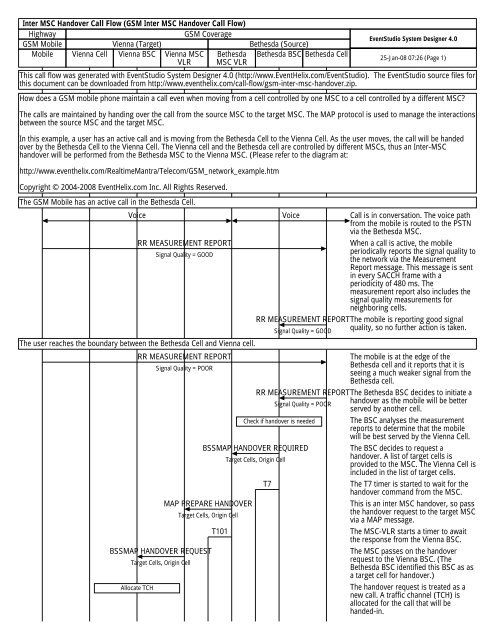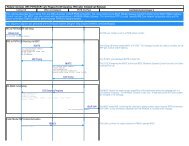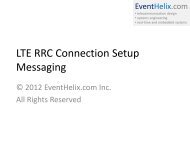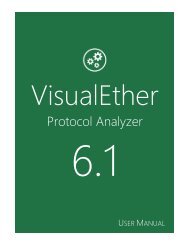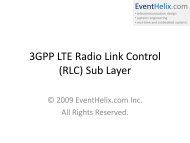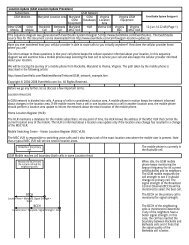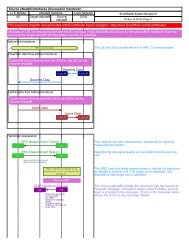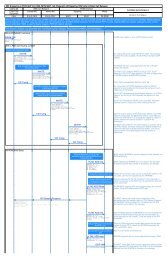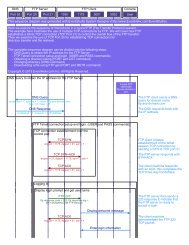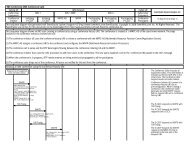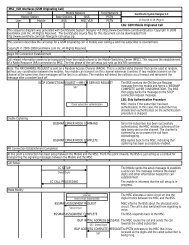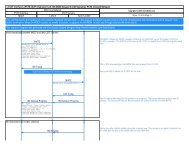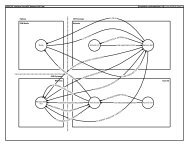GSM Inter MSC Handover Call Flow - EventHelix.com
GSM Inter MSC Handover Call Flow - EventHelix.com
GSM Inter MSC Handover Call Flow - EventHelix.com
You also want an ePaper? Increase the reach of your titles
YUMPU automatically turns print PDFs into web optimized ePapers that Google loves.
<strong>Inter</strong> <strong>MSC</strong> <strong>Handover</strong> <strong>Call</strong> <strong>Flow</strong> (<strong>GSM</strong> <strong>Inter</strong> <strong>MSC</strong> <strong>Handover</strong> <strong>Call</strong> <strong>Flow</strong>)<br />
Highway<br />
<strong>GSM</strong> Coverage<br />
EventStudio System Designer 4.0<br />
<strong>GSM</strong> Mobile Vienna (Target) Bethesda (Source)<br />
Mobile Vienna Cell Vienna BSC Vienna <strong>MSC</strong> Bethesda<br />
VLR <strong>MSC</strong> VLR Bethesda BSC Bethesda Cell 25-Jan-08 07:26 (Page 1)<br />
This call flow was generated with EventStudio System Designer 4.0 (http://www.<strong>EventHelix</strong>.<strong>com</strong>/EventStudio). The EventStudio source files for<br />
this document can be downloaded from http://www.eventhelix.<strong>com</strong>/call-flow/gsm-inter-msc-handover.zip.<br />
How does a <strong>GSM</strong> mobile phone maintain a call even when moving from a cell controlled by one <strong>MSC</strong> to a cell controlled by a different <strong>MSC</strong>?<br />
The calls are maintained by handing over the call from the source <strong>MSC</strong> to the target <strong>MSC</strong>. The MAP protocol is used to manage the interactions<br />
between the source <strong>MSC</strong> and the target <strong>MSC</strong>.<br />
In this example, a user has an active call and is moving from the Bethesda Cell to the Vienna Cell. As the user moves, the call will be handed<br />
over by the Bethesda Cell to the Vienna Cell. The Vienna cell and the Bethesda cell are controlled by different <strong>MSC</strong>s, thus an <strong>Inter</strong>-<strong>MSC</strong><br />
handover will be performed from the Bethesda <strong>MSC</strong> to the Vienna <strong>MSC</strong>. (Please refer to the diagram at:<br />
http://www.eventhelix.<strong>com</strong>/RealtimeMantra/Tele<strong>com</strong>/<strong>GSM</strong>_network_example.htm<br />
Copyright © 2004-2008 <strong>EventHelix</strong>.<strong>com</strong> Inc. All Rights Reserved.<br />
The <strong>GSM</strong> Mobile has an active call in the Bethesda Cell.<br />
Voice Voice <strong>Call</strong> is in conversation. The voice path<br />
from the mobile is routed to the PSTN<br />
via the Bethesda <strong>MSC</strong>.<br />
RR MEASUREMENT REPORT<br />
Signal Quality = GOOD<br />
When a call is active, the mobile<br />
periodically reports the signal quality to<br />
the network via the Measurement<br />
Report message. This message is sent<br />
in every SACCH frame with a<br />
periodicity of 480 ms. The<br />
measurement report also includes the<br />
signal quality measurements for<br />
neighboring cells.<br />
RR MEASUREMENT REPORTThe mobile is reporting good signal<br />
Signal Quality = GOOD quality, so no further action is taken.<br />
The user reaches the boundary between the Bethesda Cell and Vienna cell.<br />
RR MEASUREMENT REPORT<br />
The mobile is at the edge of the<br />
Signal Quality = POOR<br />
Bethesda cell and it reports that it is<br />
seeing a much weaker signal from the<br />
Bethesda cell.<br />
RR MEASUREMENT REPORTThe Bethesda BSC decides to initiate a<br />
Signal Quality = POOR handover as the mobile will be better<br />
served by another cell.<br />
Check if handover is needed The BSC analyses the measurement<br />
reports to determine that the mobile<br />
will be best served by the Vienna Cell.<br />
BSSMAP HANDOVER REQUIRED<br />
The BSC decides to request a<br />
Target Cells, Origin Cell<br />
handover. A list of target cells is<br />
provided to the <strong>MSC</strong>. The Vienna Cell is<br />
included in the list of target cells.<br />
T7<br />
The T7 timer is started to wait for the<br />
handover <strong>com</strong>mand from the <strong>MSC</strong>.<br />
MAP PREPARE HANDOVER<br />
This is an inter <strong>MSC</strong> handover, so pass<br />
Target Cells, Origin Cell<br />
the handover request to the target <strong>MSC</strong><br />
via a MAP message.<br />
T101<br />
The <strong>MSC</strong>-VLR starts a timer to await<br />
the response from the Vienna BSC.<br />
BSSMAP HANDOVER REQUEST<br />
The <strong>MSC</strong> passes on the handover<br />
Target Cells, Origin Cell<br />
request to the Vienna BSC. (The<br />
Bethesda BSC identified this BSC as as<br />
a target cell for handover.)<br />
Allocate TCH<br />
The handover request is treated as a<br />
new call. A traffic channel (TCH) is<br />
allocated for the call that will be<br />
handed-in.
<strong>Inter</strong> <strong>MSC</strong> <strong>Handover</strong> <strong>Call</strong> <strong>Flow</strong> (<strong>GSM</strong> <strong>Inter</strong> <strong>MSC</strong> <strong>Handover</strong> <strong>Call</strong> <strong>Flow</strong>)<br />
Highway<br />
<strong>GSM</strong> Coverage<br />
EventStudio System Designer 4.0<br />
<strong>GSM</strong> Mobile Vienna (Target) Bethesda (Source)<br />
Mobile Vienna Cell Vienna BSC Vienna <strong>MSC</strong> Bethesda<br />
VLR <strong>MSC</strong> VLR Bethesda BSC Bethesda Cell 25-Jan-08 07:26 (Page 2)<br />
Tune to the channel<br />
specified in the handover<br />
<strong>com</strong>mand<br />
RR HANDOVER ACCEPT<br />
Access Burst, <strong>Handover</strong> Reference<br />
Build RR HANDOVER<br />
COMMAND message<br />
BSSMAP HANDOVER REQUEST ACKNOWLEDGE<br />
RR HANDOVER COMMAND<br />
allocate<br />
<strong>Handover</strong> Number<br />
MAP PREPARE HANDOVER RESPONSE<br />
RR HANDOVER COMMAND<br />
<strong>Handover</strong> Reference, TCH<br />
RR HANDOVER COMMAND,<br />
<strong>Handover</strong> Number<br />
T101<br />
ISUP IAM<br />
<strong>Handover</strong> Number<br />
ISUP ACM<br />
BSSMAP HANDOVER COMMAND<br />
T102<br />
RR HANDOVER COMMAND<br />
T7<br />
T8<br />
At this point the Vienna BSC prepares<br />
the handover <strong>com</strong>mand that needs to<br />
be sent to the mobile. This message<br />
contains all the information the mobile<br />
will need to handover to this cell.<br />
The Vienna BSC includes the RR<br />
HANDOVER COMMAND message as a<br />
payload in the HANDOVER REQUEST<br />
ACK that is sent back to the <strong>MSC</strong>. The<br />
RR HANDOVER COMMAND will be<br />
delivered to the mobile via the<br />
Bethesda BSC.<br />
The Vienna <strong>MSC</strong> obtains a handover<br />
number from the VLR. The Bethesda<br />
<strong>MSC</strong> will use this number to initiate an<br />
inter-<strong>MSC</strong> call to carry the voice from<br />
the Bethesda <strong>MSC</strong> to the Vienna <strong>MSC</strong>.<br />
Pass the handover request<br />
acknowledgement from the target <strong>MSC</strong><br />
to the source <strong>MSC</strong>. The message also<br />
includes the handover number to call<br />
for the inter-<strong>MSC</strong> voice call.<br />
The <strong>MSC</strong> has heard back from the<br />
destination <strong>MSC</strong>, thus the T101 timer<br />
is stopped.<br />
The Bethesda <strong>MSC</strong> initiates a voice call<br />
to the Vienna <strong>MSC</strong>. The call is initiated<br />
with the ISUP Initial Address Message<br />
(IAM) addressed to the "<strong>Handover</strong><br />
Number".<br />
The Vienna <strong>MSC</strong> accepts the call with<br />
the Address Complete (ACM) message.<br />
The <strong>MSC</strong> delivers the handover<br />
<strong>com</strong>mand to the Bethesda BSC. This<br />
<strong>com</strong>mand encapsulates the RR<br />
HANDOVER COMMAND from the<br />
destination BSC.<br />
T102 is started to track the <strong>com</strong>pletion<br />
of the handover.<br />
The handover <strong>com</strong>mand has been<br />
received. So the T7 timer can now be<br />
stopped.<br />
The Bethesda BSC extracts the RR<br />
HANDOVER COMMAND message from<br />
the BSSMAP message and sends it to<br />
the mobile.<br />
T8 is started to await the clear of this<br />
call from the <strong>MSC</strong>. If the handover to<br />
the target cell is successful, the <strong>MSC</strong><br />
will initiate a resource release to the<br />
source BSC.<br />
The extracts the destination channel<br />
information from the message and<br />
tunes to the assigned channel.<br />
After tuning to the assigned channel,<br />
the mobile starts sending the handover<br />
accept message. Note that this<br />
message is sent as an access burst as<br />
the mobile is not <strong>com</strong>pletely<br />
synchronized to send normal bursts.
EventStudio System Designer 4.0<br />
<strong>Inter</strong> <strong>MSC</strong> <strong>Handover</strong> <strong>Call</strong> <strong>Flow</strong> (<strong>GSM</strong> <strong>Inter</strong> <strong>MSC</strong> <strong>Handover</strong> <strong>Call</strong> <strong>Flow</strong>)<br />
Highway<br />
<strong>GSM</strong> Coverage<br />
<strong>GSM</strong> Mobile Vienna (Target) Bethesda (Source)<br />
Mobile Vienna Cell Vienna BSC Vienna <strong>MSC</strong><br />
VLR<br />
Bethesda<br />
<strong>MSC</strong> VLR Bethesda BSC Bethesda Cell 25-Jan-08 07:26 (Page 3)<br />
T3124<br />
The T3124 timer is started to await the<br />
PHYSICAL INFORMATION message<br />
from the network.<br />
RR HANDOVER ACCEPT<br />
Access Burst, <strong>Handover</strong> Reference<br />
The BSC receives the HANDOVER<br />
ACCEPT from the terminal. The actual<br />
call is identified using the handover<br />
reference. (The handover reference was<br />
send in the encapsulated HANDOVER<br />
COMMAND message. )<br />
BSSMAP HANDOVER DETECTED<br />
The BSC informs the <strong>MSC</strong> that the<br />
handover has been detected. At this<br />
point the <strong>MSC</strong> can switch the voice<br />
path.<br />
MAP ACCESS SIGNALING REQUEST<br />
HANDOVER DETECTED<br />
The <strong>Handover</strong> detect is signalled to the<br />
Bethesda <strong>MSC</strong> via the Access Signaling<br />
Request message.<br />
RR PHYSICAL INFORMATION<br />
The BSC sends the PHYSICAL<br />
<strong>Handover</strong> Reference<br />
INFORMATION message to the mobile.<br />
This message contains a time and<br />
frequency correction.<br />
T3105<br />
T3105 is started to await the receipt of<br />
the SABM for the signaling connection.<br />
RR PHYSICAL INFORMATION<br />
<strong>Handover</strong> Reference<br />
The mobile applies the received<br />
corrections and can now send TCH<br />
bursts on the channel. TCH bursts<br />
contain the speech from the user.<br />
T3124<br />
T3124 is stopped as PHYSICAL<br />
INFORMATION message has been<br />
received.<br />
RR SABM<br />
Mobile sends a SABM to establish the<br />
signaling connection.<br />
T3105<br />
Receipt of SABM stops the T3105<br />
timer.<br />
RR UA<br />
The BSC replies with a UA message.<br />
RR HANDOVER COMPLETE<br />
BSSMAP HANDOVER COMPLETE<br />
MAP SEND END SIGNAL<br />
HANDOVER COMPLETE<br />
Switch <strong>Call</strong> to new Path<br />
ISUP ANS<br />
T102<br />
Release call resources in Bethesda BSC.<br />
BSSMAP CLEAR COMMAND<br />
T8<br />
Release TCH<br />
BSSMAP CLEAR COMPLETE<br />
The mobile uses the signaling<br />
connection to indicate that the<br />
handover has been <strong>com</strong>pleted.<br />
The BSC forwards the handover<br />
<strong>com</strong>pletion event to the <strong>MSC</strong>.<br />
Transport the <strong>Handover</strong> Complete<br />
message to the source <strong>MSC</strong>.<br />
The <strong>MSC</strong> switches the voice path.<br />
The Vienna <strong>MSC</strong> answers the<br />
inter-<strong>MSC</strong> voice call.<br />
<strong>Handover</strong> has been <strong>com</strong>pleted, so T102<br />
is stopped.<br />
<strong>Call</strong> release has been <strong>com</strong>pleted, now<br />
the RR connection is released by the<br />
<strong>MSC</strong>.<br />
The T8 timer is stopped as the handed<br />
over call's resources in the source BSC<br />
are released.<br />
The BSS informs the the <strong>MSC</strong> that the<br />
RR connection has been released.
EventStudio System Designer 4.0<br />
<strong>Inter</strong> <strong>MSC</strong> <strong>Handover</strong> <strong>Call</strong> <strong>Flow</strong> (<strong>GSM</strong> <strong>Inter</strong> <strong>MSC</strong> <strong>Handover</strong> <strong>Call</strong> <strong>Flow</strong>)<br />
Highway<br />
<strong>GSM</strong> Coverage<br />
<strong>GSM</strong> Mobile Vienna (Target) Bethesda (Source)<br />
Mobile Vienna Cell Vienna BSC Vienna <strong>MSC</strong><br />
VLR<br />
Bethesda<br />
<strong>MSC</strong> VLR Bethesda BSC Bethesda Cell 25-Jan-08 07:26 (Page 4)<br />
Voice Voice Voice <strong>Call</strong> is in conversation after the<br />
handover. Note that the voice path to<br />
the PSTN is via the source <strong>MSC</strong>. The<br />
destination <strong>MSC</strong> routes the voice on<br />
the ISUP call between the two <strong>MSC</strong>s.<br />
ISUP REL<br />
Subscribers have hung up. The source<br />
<strong>MSC</strong> releases the voice circuit between<br />
the two <strong>MSC</strong>s.<br />
ISUP RLC<br />
ISUP release <strong>com</strong>plete.<br />
MAP SEND END SIGNAL RESPONSE<br />
The handed over call has ended.


